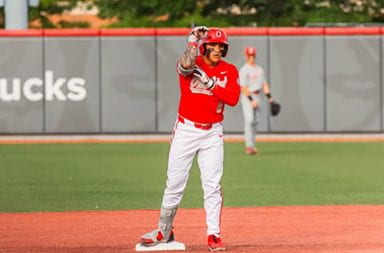The bottom line for the No. 1-ranked Ohio State men’s basketball team is that it is a perfect 22-0 after completing the first half of its conference schedule. But it’s not enough for coach Thad Matta, who continues to preach daily the value of improvement to his players.
That said, where has this team excelled, and where can it improve? Let’s put on our professor’s cap and give out some grades with nine games remaining in the regular season.
Offense: A
It’s not just the talent on the floor or Matta’s offensive system; it’s the combination of both that would make the creator of Reese’s proud. The Buckeyes are shooting 50 percent from the field, good for third in the country, thanks to their outstanding balance that allows them to work inside out.
Freshman forward Jared Sullinger has been a juggernaut on the block, scoring 18 points per game on 57.7 percent shooting. The advantage of having such a dominant post player who demands double-teams cannot be overstated, especially for a team that features as many quality outside shooters as OSU.
Veteran swingmen David Lighty, William Buford and Jon Diebler, are all shooting better than 43 percent from 3-point range. Diebler’s 47.7 percent leads the Buckeyes, who are 11th in the country in 3-point shooting at 40.7 percent. Diebler also leads the Big Ten in threes made per game at 2.86.
Add freshman point guard Aaron Craft (43.5 percent) to the mix when Matta substitutes him for Dallas Lauderdale, and you have a lineup with four capable long-range shooters paired with a dominant post presence.
Defense: B+
When players talk about Matta’s emphasis on improving every day, the question arises: At 22-0, where can this team continue to improve?
“Defense,” Buford said Friday.
Matta’s continued emphasis on defense has his team second in the conference, allowing 57.5 points per game. Although many teams choose to play zone and force oppositions to take jump shots, OSU relies heavily on a pressure man-to-man defensive scheme.
Lighty and Craft are the team’s best perimeter defenders while Buford and Diebler continue to improve. Lauderdale and Sullinger have good length and physicality in the paint, but Sullinger still has room to grow as a defender.
Lauderdale is third in the Big Ten in blocked shots per game with 1.8. But Sullinger is only averaging half a block per contest. Aside from Lauderdale and Sullinger, the team doesn’t have a quality interior defensive presence.
Lauderdale plays 18.4 minutes per game and is often substituted out for Craft, forcing the team to rely on Sullinger to protect the paint. This hasn’t been a problem yet, but look for the issue to get magnified come tournament time.
Rebounding: D
Aside from Sullinger’s 9.9 rebounds per game, no one on the team is averaging more than freshman forward Deshaun Thomas’ 4.1 per game.
During Matta’s tenure at OSU, his teams are 66-39 when outrebounded, making rebounding less important to his teams than perhaps some others. But it is something that should be looked at more closely.
The team averages 35.1 rebounds per game, meaning it relies on Sullinger for a little less than a third of its games. He averages .324 rebounds per minute. Lauderdale, the rotation’s only other post player, averages 3.9 rebounds per game and only .212 per minute.
The team needs more production on the glass from players not wearing No. 0 when the calendar flips to March.
Bench Play: B
Matta rarely uses more than two players off of his bench. Those two freshmen, Craft and Thomas, have been effective thus far.
At 28 minutes per game, Craft is getting starter’s minutes while adding 6.8 points and 4.8 assists per game. His assist numbers and 1.7 steals per game lead both the Buckeyes and Big Ten freshmen. Although he’s continued to mature on the offensive end, his real work has been done defensively.
Most notably, Craft did an excellent job defending Demetri McCamey in OSU’s win against Illinois on Jan. 22, holding the Illini’s leading scorer to five points on 2-for-11 shooting.
Thomas is still making the transition from being the best offensive player on his high school team to becoming more well-rounded and making contributions off the bench.
“In high school, I had the green light since freshman year,” Thomas said Friday. “That came comfortable to me. … If I’m open, I’m going to try to shoot it.”
The lanky southpaw is shooting 50.3 percent from the field, but only 27.9 percent from 3-point range.
While those two freshmen are playing as well as — if not better than — expected off of Matta’s bench, it is asking a lot of his team only to use seven players. In a physically demanding conference, expect this to become a topic of discussion during the second half of conference play.
Coaching: A
Synonymous with coaching in Division I basketball is the ability to recruit, and this year’s freshman class is as good as any. Credit Matta for not only landing Sullinger, but Craft and Thomas as well.
What’s often overlooked in sports is the mentality of a team sitting all alone at the top. It’s one thing to be talented; it’s another to maintain mental toughness. Matta has done an excellent job of keeping his team mentally prepared and away from all the hype and attention that comes with the nation’s No. 1 ranking.
Tactically, Matta does well teaching fundamentals, especially on the defensive end. By doing so, his key players are able to avoid getting into foul trouble, which could be bothersome to a team that consistently plays the same seven players.
He’s excelled at grooming his freshmen. By keeping Craft on the bench and out of the starting lineup, Matta doesn’t over-rely on him because he’s the only true point guard in the rotation.
Forcing him to watch the first few minutes of each game from the bench allows Craft to evaluate the game’s tempo, come into the game and adjust to it accordingly.
Though there are numbers to evaluate players from every angle, there’s really only one needed to evaluate a coach at the college level: 22-0. Not bad at all.


